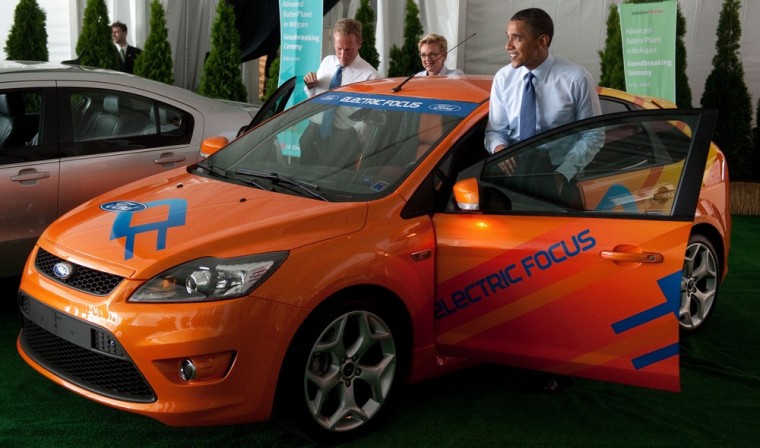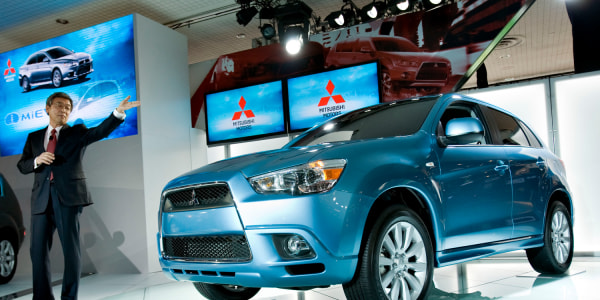Should new cars be required to get 62 miles per gallon by 2025? That's one scenario under an Obama administration notice filed Friday for drafting mileage standards on model years 2017 to 2025.
The fleet of new vehicles may need to meet a standard set somewhere from a low of 47 mpg to a high of 62 mpg, the administration said in its notice of intent.
An initial assessment shows the additional costs for producing high-mileage vehicles ranges from just under $800 to $3,500, the notice stated, but those costs could be "higher" when a more detailed analysis is completed by November.
The notice added, however, that the changes would lead to "lifetime savings due to reduced fuel costs of about $5,000 to over $7,000."
Moreover, the mileage gains would be the equivalent of an annual decrease in carbon dioxide emissions per mile of 3 to 6 percent.
The move is framed as a way of attacking climate change, reducing U.S. dependency on foreign oil and growing the economy through cleaner energy jobs.
The administration's notice of intent was released by the Transportation Department and the Environmental Protection Agency, laying the groundwork for a proposal to be issued in September 2011 and approved by July 2012.
It gives automakers, environmental groups and states an overview of the possible standards, describe the technologies that would be needed to achieve those goals, and seek feedback from the public and industry.
David Strickland, the administrator of the National Highway Traffic Safety Administration, said the notice lays out the game plan for the proposal but that the government would not make any decisions "until we have the data and the facts and the science behind us."
The time period in question may seem "like a long way away, but it isn't," Strickland said. "We're looking at a lot of technologies on the horizon that could be incorporated into the fleet."
35.5 mpg by 2016
Cars emit about 20 percent of the nation's carbon emissions and consume about 44 percent of its oil, figures show, and President Barack Obama said in May he thought it was possible for cars and trucks to cut their fuel use and carbon emissions by half within 20 years.
After little progress during the past three decades, rules adopted earlier this year will lift the new vehicle fleet average to 35.5 mpg by 2016, an increase of more than 40 percent over current standards.
Environmentalists are behind measures to increase vehicle efficiency, but automakers argue that pushing gas mileage standards up that quickly through 2025 could force them to raise prices higher than drivers can afford.
The standards are designed to improve gas mileage across each automaker's lineup and across the nation's entire fleet of new vehicles. Vehicles must meet differing standards based on their dimensions. Compact cars must get better mileage than sport utility vehicles, for example, but requirements for all types will go up.
Environmental groups say a mix of gas-electric hybrids, electric vehicles and improvements to conventional vehicles could create a vastly more efficient fleet. A target of 60 mpg by 2025 would translate to about a 6 percent improvement each year.
Not all of industry on same page
But the Alliance of Automobile Manufacturers said many different factors must be considered to set the maximum feasible level of fuel economy and greenhouse gas reductions.
"The danger is that a standard is put forth that increases fuel economy too quickly, adding unnecessary cost and effectively pricing consumers out of the market," said industry spokesman Charles Territo.
Other parts of the automotive industry have a different take.
Aluminum suppliers, for example, were quick to tout the benefits of light-weight aluminum over traditional steel in vehicles.
"When it comes to shaking up the status quo on automotive fuel economy and emissions, aluminum can be a game changer," Randall Scheps, a spokesman for the Aluminum Association, said in a statement. "Weight is the enemy of efficiency and that’s why vehicle weight — not vehicle size — must be reduced significantly in concert with engine technology."
Suppliers of hybrid and all-electric vehicles also stand to benefit.
Later this year, several automakers will begin releasing plug-in electric hybrids and electric cars. General Motors is releasing the plug-in Chevrolet Volt, and Nissan begins selling the all-electric Leaf, opening a new wave of mass-produced electric vehicle options.
"You will have to go with the alternative that's on the table now," said John O'Dell, senior editor of Edmunds Green Car Advisor.com. "Some combination of electricity with or without an engine — conventional hybrid, plug-in, extended range. It will be a combination of those things."
Conventional hybrid automobiles are the only vehicles on the road today with a measure of commercial popularity that could come close to meeting new aggressive government targets for fuel savings and emissions reductions, these experts say.
Slideshow 27 photos
The 2010 New York International Auto Show
Prius now at 51 mpg
For instance, the 2011 Prius achieves 51 mpg city/48 highway. It runs on a nickel-metal hydride battery pack and a gasoline engine.
Hybrid sales overall are down this year and represent roughly 2 percent of the U.S. automotive sales market, roughly 150,000 cars for 2010 through August. Prius accounts for about two-thirds of the total, according to industry sales figures.
Hybrid sales have traditionally gotten a boost from high gasoline prices, which this year have remained steady around $2.70 in 2010 after dramatic price swings in recent years. In 2008, gasoline hit a record $4 a gallon.
Government tax breaks and manufacturer incentives have also helped sales and some of those have expired.
O'Dell believes 10 percent market penetration would put hybrids in the mainstream — about 1 million in sales. A 4.5 percent annual gain in fuel efficiency over 2016 levels would put the industry at 53 mpg.
Brendan Bell, a lobbyist for Union of Concerned Scientists, believes the entire family of hybrid/electric vehicles could shoot to more than 50 percent of the market by 2025, depending on gasoline prices and incentives.
All-electric vehicles, because they use zero gasoline, are not measured in terms of miles per gallon of gas, but their operational costs are much less and they don't emit CO2 so they would easily make a 62-mpg equivalent ranking.
Still, obstacles to wider electric vehicle deployment include securing a steady and not costly supply of materials for nickel-metal hydride, lithium-ion, and other batteries used to power those cars.
The government is also expected to soon release a proposal for first-ever fuel efficiency and emissions standards for medium-duty and heavy-duty trucks beginning with the 2014 model year.

